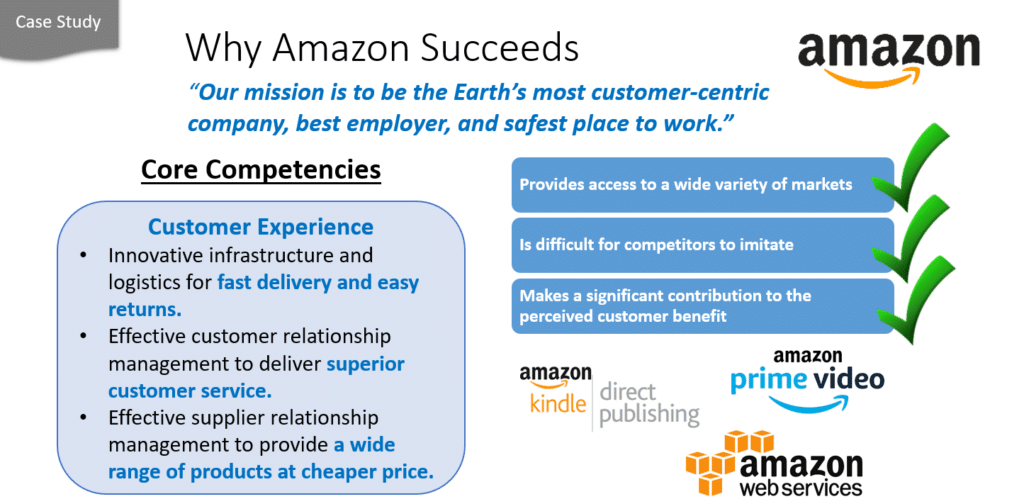In these most challenging of times, organizations are well served when they analyze, embrace and leverage what makes them special in the eyes of those they serve. Such an analysis is often referred to as a core competency analysis. Such an analysis defines the bundle of skills and technologies that enable a company (or organization) to provide a particular value to a customer.
Amazon: An Example of Leveraging Core Competency
A perfect example is Amazon. We know Amazon is striving to be, in their words, “earth’s most customer-centric company.” In this example we see that Amazon’s core competencies are centered on providing a premier customer experience via fast delivery, superior customer service and access to a wide range of products at a lower cost. These capabilities provide access to a wide range of markets, are difficult for competitors to imitate and make a significant contribution to the perceived customer benefit. Amazon’s ability to build, leverage, and reconfigure its core competencies into sustainable competitive advantages exemplifies why they are supremely well positioned to expand their offerings and succeed in a rapidly changing external environment.

Where to Begin when Identifying Core Competency
The starting point for understanding core competencies is recognizing “competition” between organizations is both a contest for “competence mastery” and “market position and power”. Careful consideration should be given to what internal capabilities the organization possesses that are recognized by customers as its competitive advantage. The core competency of the organization becomes the focus around which relevant business opportunities are chosen and strategic direction is defined.
The Origin of Core Competency
The main ideas about core competencies were first developed by Gary Hamel and C.K. Prahalad in the early 90s. The central notion behind their work is that, over time, organizations develop key areas of expertise that are distinctive to their business and critical to its long-term growth. From a profit-making perspective, Prahalad and Hamel suggest three factors that help to identify core competencies in any business organization:
- Provides access to a wide variety of markets
- Is difficult for competitors to imitate
- Makes a significant contribution to the perceived customer benefits
Core Competency in Public and Nonprofit Sectors
For government and nonprofit organizations, understanding core competencies are critical to identifying where programs and services can/should be delivered in an efficient cost-effective manner. Should program A be housed in the Federal Department of Education, the Department of Energy, or administered at the state level? Would citizens or clients be better served by program B’s being funded from state tax revenues or from county collections, or from both?
Leveraging Your Core Competency
These areas of expertise may be in any dimension of the organization but are most likely to develop in the critical organizational processes where the most value is added to products and/or services. A core competency can be any area, factor, or consideration perceived by the customer that differentiates the organization and provides for a competitive edge over its rivals.
Below are typical areas where core competency can be found:
- Quality of the product or service – high above industry standards
- Fill a special niche
- Strong consumer orientation – leading to a high degree of customer intimacy
- Service levels – high above industry standards
- Operational efficiency – leading to low-cost provider
- Reputation and brand image – established over many years of outstanding performance
- Site selection – “location, location, location”
- Special and unique technical skills of one or more people on the team
Once these areas of expertise are identified, alternative strategies should be assessed to determine what productive or synergistic match exists between a particular scenario or strategy and the core competencies of the organization. To the extent leadership teams select strategies that leverage their core competencies, they are better able to take advantage of capabilities already valued by their customers and therefore mitigate their overall risk profile.
Core competencies should be viewed as dynamic elements that evolve over time in response to the organization’s operating environment. It is possible to develop a competency into a core competency and in so doing it becomes “competitively unique.” In many sectors, most skills can be considered a prerequisite for participation and do not provide any significant competitive differentiation. To qualify as core competency, a competency must be an attribute that is valued by the customer and that competitors wish they had within their own organization. A competency that is central to the organization’s operations (yet not exceptional in some way) should not be considered a core competency since it does not differentiate the organization from its competitors.
Amazon has for sure taken this rationale to heart. If your organization is not following this practice, maybe it is time to do so.
Learn more about the value of focusing on your organization’s core competency!
Enrolling now in one of our upcoming Mastering Strategy programs
CLICK HERE for more information and to register.
